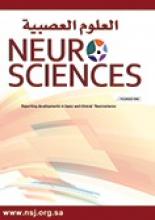Abstract
OBJECTIVE: Clobazam is a newer 1,5-benzodiazepine used for the treatment of epilepsy. It is better tolerated and less sedating than other benzodiazepines. It has yet to gain wide use for epilepsy in the Middle East. Our objective is to report our experience with clobazam for the treatment of childhood epilepsy.
METHODS: A cohort of children with intractable epilepsy, defined as recurrent seizures after at least 3 anti-epileptic medication trials, were included prospectively. Clobazam was added to a maximum dose of 2 mg/kg/day. Follow-up by two pediatric neurologists was performed. Therapeutic response was recorded as complete (no seizures), good (>50% seizure reduction), fair (<50% seizure reduction), or none.
RESULTS: Thirty one children (21 males - 10 females), aged 2 months-15 years (mean 4.6 years) were followed for 3-12 months. Most children (68%) had daily seizures and were on multiple anti-epileptic drugs (mean 2.3, +/- SD 1). Fourteen (45%) children had Lennox-Gastaut Syndrome. After the introduction of clobazam, 11 (35.5%) became completely seizure free and 14 (45%) had >50% seizure reduction. Side effects were reported in 7 (22.5%) in the form of excessive sedation, vomiting, irritability, behavioral change, and ataxia. In 4 children these side effects resolved either spontaneously or with dose reduction.
CONCLUSION: Clobazam is a well tolerated, safe, and very effective antiepileptic drug. It has a broad spectrum of antiepileptic activity, minimal side effects, and is relatively inexpensive. Wider use of this drug is recommended in children with intractable epilepsy.
- Copyright: © Neurosciences
Neurosciences is an Open Access journal and articles published are distributed under the terms of the Creative Commons Attribution-NonCommercial License (CC BY-NC). Readers may copy, distribute, and display the work for non-commercial purposes with the proper citation of the original work.






